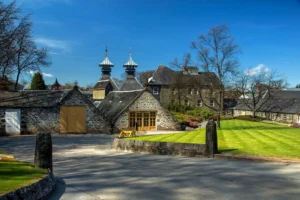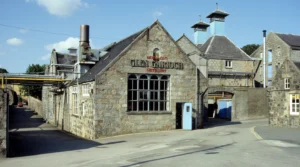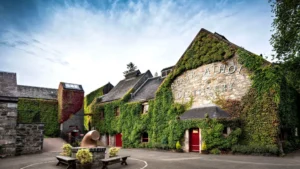Scotland has some of the world’s oldest distilleries, which have been honing whisky for decades. The first whisky distillery opened around 1690. Explore them here.
Which one are you going to visit first? 🧐
Glenturret, Est. 1763: The Pinnacle of Antiquity

Glenturret was formerly known as Thurot, then Hosh, until adopting the name Glenturret in 1875. The name was really inherited from a short-lived neighbouring distillery that operated from 1826 to 1852.
Glenturret was acquired by the Lalique group in 2019, and the company soon began updating the core line and negotiating collaborations with other luxury brands. Their intentions for the distillery are expected to be echoed by the Michelin star they earned in 2022.
Bowmore, Est. 1779: Islay’s Time-Honoured Gem

Bowmore, taking pride in being Islay’s oldest distillery, boasts a history rich with exceptional releases. The Black Bowmore, introduced in 1993, stands as a collectors’ favourite, representing the zenith of whisky craftsmanship.
Notably, Bowmore commemorated its bicentennial in 1979 by releasing a replica hand-blown decanter of 1964 vintage whisky matured in their legendary №1 Vaults — which, by the way, are also regarded Scotland’s oldest whisky maturation warehouse.
Strathisla, Est. 1786: Speyside’s Cherished Old Guard

The venerable Strathisla distillery holds the honour of being the region’s oldest. Known for its picturesque twin pagodas and water wheel, it is synonymous with Chivas Regal, one of the world’s most popular Scotch whiskies.
Many older distilleries changed their names. Strathisla was founded in 1786 as Milltown, then changed to Milton, before becoming Strathisla in 1870. After changing it back to Milton in 1890, the owners finally re-reverted it to Strathisla back in 1951.
Balblair, Est. 1790: A Legacy of Exclusive Vintages

Balblair may be one of the smallest, but its focus on select vintage releases (and the internationally promoted blend Hankey Banister) has made it a treasure trove for whisky collectors worldwide.
Balblair’s long history has resulted in some remarkable vintage whiskies, including highly sought after and highly rated 1949 and 1951 vintage bottlings that exemplify everything wonderful about collecting vintage whiskies.
Oban, Est. 1794: Diageo’s Historic Jewel

Oban isn’t just the fifth oldest but also Diageo’s oldest distillery. Nestled at the heart of its namesake town, Oban is known for its exclusive vintage malts and has been a centerpiece in Diageo’s special releases.
Despite its small output, Oban has been at the centre of many Diageo special releases. It features an amazing variety of collectable vintage malts, like the bicentenary Managers Dram. It’s also popular among independent bottlers like Moon Import.
Glen Garioch, Est. 1797: A Resilient Veteran

Glen Garioch has weathered turbulent times, including multiple closures, first between 1968 and 1973 and then again between 1995 and 1997.
Suntory already owned Bowmore, which is known for its peated Islay style. So, since its reopening in 1997 under Suntory management, Glen Garioch has transitioned from peated to unpeated whisky, demonstrating the distillery’s adaptability.
Rosebank, Est. 1798: A Controversial Revival

There’re many controversial claims about Scotland’s oldest distilleries. Rosebank name was first used in 1840, but it closed in 1993 due to the 1980s downturn, the high cost of upgrades, and Diageo’s focus on other distilleries.
Rosebank reopened in 2017 under new owners, by which time most of the distillation equipment was stolen. Rosebank “reopened” in 2022 with the exact replicas of the original equipment. But the question is, what is it that makes a distillery or whisky one of a specific name?
Blair Athol, Est. 1798: Diverse Histories

In 1798, three distilleries were formally built, the oldest of which is said to be Blair Athol. It is home to Bell’s blended whisky and was one of Scotland’s most popular visitor centres with over 80,000 people a year until covid.
Globally, the Bell’s blend has lost popularity in recent years, and while it remains number two in the UK, it begs the question of what Diageo has planned for the brand and its spiritual home, Blair Athol.
Tobermory, Est. 1798: Standing Strong

Tobermory was the name given to the distillery when it originally opened, and it closed for the first time in 1837. It did not reopen until 1878, when it began distilling whisky and closed again in 1930.
After another long closure, the distillery was renovated and reopened as Ledaig in 1972. After three years, the new owners declared bankruptcy and renamed the company Tobermory in 1979. Today the distillery produced both Tobermory whisky and a peated Ledaig expression.
Highland Park, Est. 1798: The Last of the 18th Century

Highland Park became the last to be legally established in the 18th century. It was one of the forerunners of the single malt revival and continues to celebrate its heritage with a global presence.
Highland Park promoted themselves as a single malt globally since 1979, pioneering the single malt. Their proactive approach allowed them to construct a visitor centre in 1986, when other distilleries were closing due to a market downturn, despite their distant location.
Wrapping Up
This exploration is more than a mere recounting of dates. It’s a reflection on the significance of heritage in the whisky industry. While age is a noteworthy factor, it’s the blend of tradition, innovation, and craftsmanship that truly cements a distillery’s reputation.
It is humbling to realise how long the whisky industry has existed and thrived. We only covered ten, but the top 30 Scotch distilleries are all over 200 years old. Cheers to the next 200 years!

Hi, this is a comment.
To get started with moderating, editing, and deleting comments, please visit the Comments screen in the dashboard.
Commenter avatars come from Gravatar.